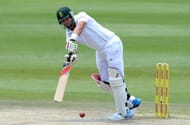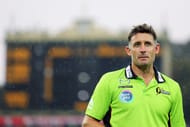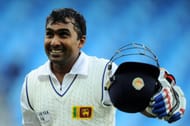Harsha Bhogle once remarked-“Another flower must bloom, another boy must become a man.”This beautifully sums up the essence of retirement in a sport. The aura of our champion players seems to grow with each day after they are gone. All their failures on the turf are tucked in nicely in some dingy corner of our heart as we continue basking in the glory of the numerous achievements that defined their celebrated careers. And yet, the greedy fan inside us wants to have yet another glimpse of our hero; holding the bat, spinning the ball or intercepting the odd ball near the fence. Here’s a list of 6 retired players who would still find a place in their respective teams:
#1 Shane Warne

Some facts I am sure of. It was 1993; Old Trafford, First Ashes Test and Australian captain Allan Border had just tossed the ball to the young leg-spinner – Shane Warne. Facing him was England batsman- Mike Gatting who was well-known for his ability against spin bowling.
Some field adjustments ensued and Warne was ready to bowl his first ball in an Ashes Test. Slowly ambling to the crease, he tossed the ball up on leg stump, the ball drifting further down the leg-side, dipped alarmingly before turning almost a yard or two and swerved past the hapless blade of Gatting to nip the top of off-stump, sending the Australians in a state of utter frenzy. Gatting just stood there, dumbfounded, bamboozled by a magic delivery trying to figure what had just happened.
As he started the long walk back to the dressing room, still shaking his head in disbelief, the delivery that had just got him out got imprinted in the echelon of cricketing grandeur as – “The Ball of the Century”.
“That ball”, as it is often referred to, not only set the tone for the remainder of the series but also revived the dying art of leg-spin. Leg-breaks were in fashion again and a noble-calling in the sport had just found its most devoted practitioner.
Over the next 15 years, Shane Warne became the linchpin of an Australian bowling attack that ran through opposition, changing the course of the match on umpteen occasions. If a batsman started spotting his booming leg-break, he turned to his other variations like the flipper and the wrong-un to breach the batsman’s defence.
However, mind-games were as much a part of Warne’s armoury as the flipper and the wrong-un and he would use it profligately to get under the opponent’s skin. His battles with South African great- Daryl Cullinan in the early 1990s and more recently, with the batting maestro- Sachin Tendulkar are part of the cricket folklore.
In a career that spanned over 15 years, Warne played a total of 145 Tests in which he took 708 wickets at an astonishing average of 25.41. He also played 194 ODIs for Australia where he took 293 wickets at an average of 25.73; a grand tally of 1001 international wickets against a backdrop of a craft that wasn’t just fascinating but equally incisive. Shane Warne’s a one-off and easily the best leg-spinner the game of cricket has ever seen. And at a time when Australia has struggled to produce another leggie of his pedigree, there’s clearly room for Warne in the playing XI if he’s entertaining any thoughts of a comeback.
#2 Jacques Kallis

Andrew Miller, in one of his pieces on Cricinfo, once remarked that the greatest sporting moments often occur at the crossover point between discipline and instinct. Nothing quite matches the adrenaline rush of the sight of a batsman swaying out of the line of a well-directed bouncer. This calls to mind a fine memory involving Jacques Kallis.
Kallis, at the time he retired, had carved out a mountain of runs and was numerically superior to his predecessors but my memory of him is one when he did nothing and was done in by a vicious bouncer from Indian pacer-Sreesanth. There’s nothing much that Kallis could have done about it, really but the fact that he still managed to get out of the way speaks volumes about his technique and alertness. That, he still got out is a mere testament to the peach of a delivery that Sreesanth had bowled.
There’s rarely a sight more exhilarating than watching Kallis go on the back-foot to play a crushing drive or his trademark inside-out shot over the in-field. And if the opposition somehow managed to find a glitch in his shield, he would come back to haunt them with the ball. When he is doing neither, he would stand in the slips like a prowler waiting for his prey and pouch the ball safely with his bucket-like hands.
As a ubiquitous all-rounder, Kallis has always bailed his side out of trouble and has been instrumental in South Africa’s steady ascent over the years. He may not have been as flamboyant as AB de villiers or as nimble on the field as some of his other team-mates but his effortful and flourishing method meant that he was always on top of his game and a tough nut to crack for the opposition.
Here are Kallis’s colossal numbers- 13, 289 Test runs at an average of 55; 292 wickets at an average of 32 and a tally of 200 catches. The ODI numbers are equally impressive- 11579 runs at an average of 45; 273 wickets at an average of 32 and a tally of 131 catches.
As Mike Jakeman correctly pointed out in one of his essays- textbook technique plus cool head equals deadening cricket; that’s the Kallis equation. Surely then, South Africa wouldn’t mind if Kallis were to give a second-thought to his come-back.
#3 Michael Hussey

He may not have Ponting’s brashness or Gilchrist’s bravado with the bat but his dependability, enthusiasm and competitive drive ensured that he was the backbone of the Australian middle order for over a decade. In 2006, a year after he made his debut, he scored 458 runs in 7 innings against England at an awe-inspiring average of over 91. Then, his career average was hovering in the eighties and he appeared nearly invincible, much like his team.
Technique-wise, foot-position and movement are the key tenets to batting and Michael Hussey was good at using his feet against the spinners, always coming down to the pitch of the ball seldom leaving any room for error. No real surprises he’s one of the few Australian batsmen who has had fair amount of success playing against India in the sub-continent conditions.
All his life, Hussey has batted with players who could press foot on the pedal whenever they felt the need but he didn’t commit the folly of being embarrassed about grafting it out in the middle while others around him went about scoring at a brisk pace. However, once he got his eye in, he had the ability to up the ante by taking the attack to the opposition.
In almost a decade-long international career, Hussey played 79 Tests for Australia in which he scored 6235 runs at an average of 51 along-with 185 ODIs in which he accumulated 5442 runs at an average of 48. Judging by the sheer weight of his numbers, Michael Hussey would still be a strong contender for the baggy green.
#4 Graeme Smith

A broken hand and an injured elbow wasn’t enough to stop Graeme Smith who came out to bat hoping to salvage a draw from the jaws of defeat in a Test match against Australia, back in 2009. Australia eventually went on to win the game but the then South African skipper had the last laugh as his side took the series and Smith walked away with the award for Man-Of-The-Series.
Having been made captain at the young age of 22, Smith had to shoulder the responsibility of reinstating belief in a side that looked rather rudderless after the ignominious events of match-fixing had rocked its very foundation. He carried out his duties with aplomb and didn’t let his teammates down.
A southpaw of the highest ilk, anything on his pads was flicked away through mid-wicket and width outside off-stump was almost always met with utter disdain and driven effectively through covers.
Smith represented South Africa in 117 Tests in which he scored 9265 runs at an average of 48 and also played 197 ODIs amassing 6989 runs at an average of 38. But, Smith’s legacy goes well beyond those numbers and as Mark Nicholas would tell you- he was a great cricketer all right but he will always be remembered for his unwavering leadership during the most challenging era when South African cricket was at its nadir.
South Africa would love to see their hero in action.
It isn’t too late for another swing, is it Biff?
#5 Daniel Vettori

Daniel Vettori, the world’s most successful left-arm spinner made his debut for New Zealand at the young age of 18 in a Test match against England in February 1997. Known for his ability to turn the ball on unsympathetic surfaces, Vettori brought parsimony to the wily art of spin bowling.
He didn’t have the magic of Muralitharan or the mystifying guile of Warne, but he compensated by bringing intelligence to the craft that earned him 362 wickets from 113 Tests at an average of 34 and 305 wickets from 295 ODIs at an average of 32. Outside Asia, where the conditions aren’t generally conducive for spin bowling, he took 228 wickets, second only to Shane Warne who took 237. By the time Vettori decided to hang his boots, he had bowled 43,661 deliveries- the fourth most by any bowler in international cricket.
At his best, Vettori wasn’t just an economical left-arm spinner but a handy lower order batsman too. 4531 runs at an average of 30 in Test cricket aren’t bad for a player who played in the side primarily as a spinner.
If Vettori plans on donning the black cap again, the doors will always be open.
#6 Mahela Jayawardene

The lazy elegance of Mahela’s batsmanship is what struck me the most about him during his playing days. He never thumped the ball, he caressed it. He never walloped the gap; he pierced it with surgical precision.
He was flawless in his timing, subtle in his depth and silky in his deft touches. Once in, he could bat for hours at a stretch, sending the opposition fielders on a luckless leather hunt. He wasn’t intimidating like Sanath Jayasuriya or belligerent like Dilshan, but he had the ineffable resolve of a batsman who was out there to lay waste to the opposition’s plans. For a player of the classic mould, he took to T20 like fish to water scoring briskly when necessary and being watchful when the need arose.
11,814 runs from 149 Tests at an average of 50 and 12,650 runs from 448 ODIs at an average of 34 are a testament to a batsman who has remained at the peak of his prowess for most part of his illustrious career. And Sri Lanka would be more than happy to have him back in their ranks.
Brand-new app in a brand-new avatar! Download CricRocket for fast cricket scores, rocket flicks, super notifications and much more! 🚀☄️
